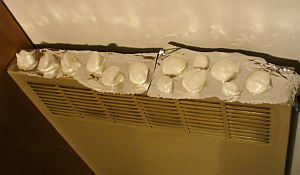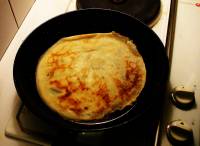 Even if I'm not an expert in molecular gastronomy, I'm often very impressed by transformations of form, color or texture that happen when I cook. It's so nice the mutations of those choux au Comté in the oven, or how beaten egg whites can turn into crisp meringues on my radiator. Don't worry, I won't talk about chemistry and how those reactions work, but just to what extent it can work.
Even if I'm not an expert in molecular gastronomy, I'm often very impressed by transformations of form, color or texture that happen when I cook. It's so nice the mutations of those choux au Comté in the oven, or how beaten egg whites can turn into crisp meringues on my radiator. Don't worry, I won't talk about chemistry and how those reactions work, but just to what extent it can work. Recipes are so accurate: you get a list of ingredients with exact quantities, and how to use them, but no warranty on what happens if you don't exactly respect the quantities. That's why I will define a tool to represent ingredient quantity robustness in a recipe in this post: the ingredient polyhedron. And a method to compute it from many receipes of the meal you want to cook, found on the web for example. My example will be crêpes, our French flat pancakes.
Recipes are so accurate: you get a list of ingredients with exact quantities, and how to use them, but no warranty on what happens if you don't exactly respect the quantities. That's why I will define a tool to represent ingredient quantity robustness in a recipe in this post: the ingredient polyhedron. And a method to compute it from many receipes of the meal you want to cook, found on the web for example. My example will be crêpes, our French flat pancakes.This dessert is done with roughly 3 ingredients (and of course butter for the pan, but we will just speak about ingredients of the batter), we will thus get a very nice 3D picture. So: eggs, flour, milk, those ones appear in all of the 19 recipes I've gathered in this OpenOffice spreadsheet file thanks to the following websites: lejus.com, 1001delices.net, recette-crepe.net, goosto.fr, supertoinette.com, recettes.qc.ca and the French reference Marmiton (sorry for my vegan friends). But maybe I'll just start with 2 ingredients to show how the whole thing works. Say we have already decided the number of eggs to use, one for example. We then compute according to all recipes, with a rule of three, the quantity x of milk and y of flour that have to be added (I translated everything to grams for simplicity). Those coordinates can then be plotted on a graph, to get the following dots:
 From the lower left to the upper right, the number of eggs in the recipes decreases (as there is more and more flour and milk). On the upper left corner we have lots of flour, and on the lower right corner, more milk. And what is this kind of elastic band which sticks around the dots? It's some kind of safety area: any point within this area should correspond to ingredient quantities that works for the recipe. Well, at least that's what I hope: any point of the segment between any two points that work should work too, send me your counterexamples if you do not agree. Anyway, this area is called the convex hull of the point set, and there are many algorithms to compute it automatically. So of course to avoid taking risks you may want to target the middle of the convex hull. Notice that 3 recipes with the same main ingredient quantities correspond to a quite central dot (half a liter of milk and 250 grams of flour for 3 eggs).
From the lower left to the upper right, the number of eggs in the recipes decreases (as there is more and more flour and milk). On the upper left corner we have lots of flour, and on the lower right corner, more milk. And what is this kind of elastic band which sticks around the dots? It's some kind of safety area: any point within this area should correspond to ingredient quantities that works for the recipe. Well, at least that's what I hope: any point of the segment between any two points that work should work too, send me your counterexamples if you do not agree. Anyway, this area is called the convex hull of the point set, and there are many algorithms to compute it automatically. So of course to avoid taking risks you may want to target the middle of the convex hull. Notice that 3 recipes with the same main ingredient quantities correspond to a quite central dot (half a liter of milk and 250 grams of flour for 3 eggs).The convex hull also shows the robustness of the recipe according to each parameter, that is how accurate you have to be when measuring each ingredient. Note how narrow the convex hull is (it would be even more if I had chosen the same vertical and horizontal scale). This means that depending on the recipe, the quantity of eggs may vary a lot, but not the proportion milk/flour. We can plot for each recipe the difference between the ratio of two ingredients, and the average ratio for those two ingredients:

If you do the average of the absolute value of those deviations, you get: 16% for the milk/flour ratio, 28% for flour/eggs, 31% for milk/eggs. The milk/flour ratio varies much less than the other ratios among the recipes, so you have to be more careful in this proportion than when choosing the number of eggs. So we have just illustrated and proven this nice theorem: the recipe of crepes is pretty robust to the variation of the number of eggs.
You can also have fun by showing many desserts which share the same main ingredients on the same graph:
 Well, just wait before pouring your "pâte à crêpes" onto waffle iron: you may want to add some baking powder and vegetable oil...
Well, just wait before pouring your "pâte à crêpes" onto waffle iron: you may want to add some baking powder and vegetable oil...To conclude, let's take a look at the 3D ingredient polyhedron thanks to this very nice applet by Tim Lambert (he even shares the source that I was able to modify to include my crepes points), you can use the mouse to control and move it:
 Here again what wa see is a convex hull, in 3 dimensions, on dots (x,y,z) where x is the number of eggs, y the quantity of milk and z the quantity of flour. I put the dots by choosing a minimum limit and a maximum one on the number of eggs to get this frustum, such that any cut perpendicular to the x axis (for a constant number of eggs) gives exactly the same convex hull polygon as above. To really use it we should let the user enter the quantity of ingredients he just used: if the dot gets inside the polyhedron, no problem, otherwise... you may try the restaurant tonight!
Here again what wa see is a convex hull, in 3 dimensions, on dots (x,y,z) where x is the number of eggs, y the quantity of milk and z the quantity of flour. I put the dots by choosing a minimum limit and a maximum one on the number of eggs to get this frustum, such that any cut perpendicular to the x axis (for a constant number of eggs) gives exactly the same convex hull polygon as above. To really use it we should let the user enter the quantity of ingredients he just used: if the dot gets inside the polyhedron, no problem, otherwise... you may try the restaurant tonight!
No comments:
Post a Comment